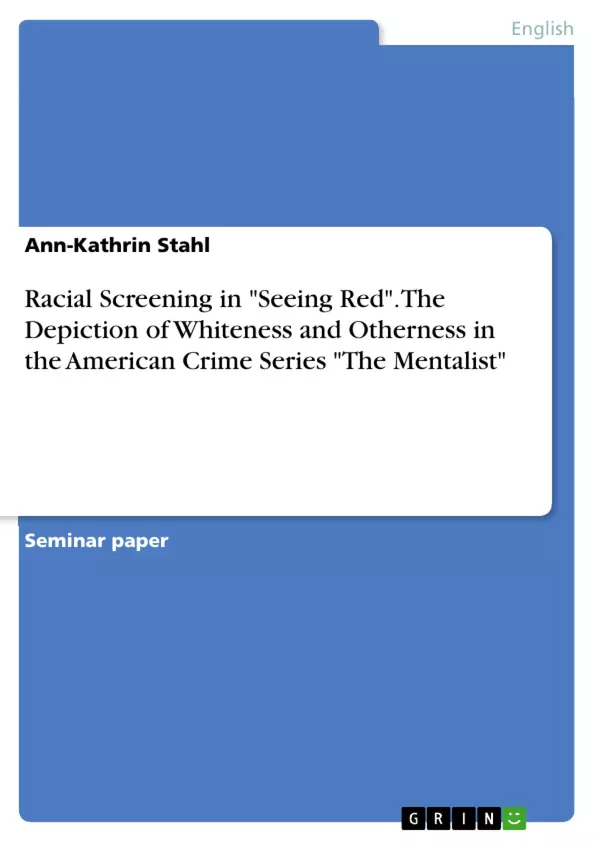One serial example focusing on ethnic inquiry is presented by the episode “Seeing Red” of the mystery detective series The Mentalist. The series was created by British writer and producer Bruno Heller and it first aired in 2008. It tells the story of Patrick Jane. Having worked as a clairvoyant in his past, he attracted the attention of the serial killer Red John. After this killer murdered Jane’s family, he starts to work as a consultant for the California Bureau of Investigation (CBI) in order to find Red John and to perform his revenge. In the course of his work for this agency, he helps the team solve various other crimes until he finally finds Red John. Even though this episode might at first sight be simply overlooked as another prime time crime series, a critical analysis of the production reveals its complex structure. This structure consists of interwoven social and ethnic relations that are delineated in various ways. Especially, great emphasis is put on Asianness, Irishness, and Whiteness and the way these ethnic groups socially interact with each other. Thus, this paper aims at exploring the filmic deployment of Whiteness and Otherness in specific contexts. The central hypothesis discussed in this paper is that although at first glance, the conception of “Seeing Red” seems to propagate multicultural postracial ideals of contemporary US American TV-series, it secretly serves to perpetuate the legacy of the superiority of the WASP.
In order to serve this purpose, the paper will first take a closer look at the way ethnicity is depicted in “Seeing Red”. In the center of attention are Irishness, Asianness, and Whiteness and how they are portrayed in this episode of The Mentalist. The second part of the paper will then demonstrate to what extent the employment of stereotypes in “Seeing Red” serves to perpetuate and reproduce WASP-related structures. To encode the underlying racial notions that advocate white supremacist standards, the chore cast of this episode is analyzed from a critical point of view. Lastly, the paper concludes by summarizing the main findings and giving a brief outlook on points of inquiry for future research projects in this specific context.
Table of Contents
- Introduction
- The Depiction of Ethnicity in “Seeing Red”: Whiteness and Otherness
- The Delineation of Otherness: Racial Stereotyping in Seeing Red
- Irish Americanness
- Asian Americanness
- The Persistence of Whiteness in “Seeing Red”
- The CBI’s Headquarters in Sacramento: A Cultureless Vacuum?
- Whiteness vs. Asianness: Of Recreational Ethnicity and Biracial Buddy Cop-Teams
- Mentalist vs. Spiritual Advisor: Manipulation for the Benefit of the WASP
Objectives and Key Themes
This paper examines the depiction of ethnicity and racial relations in the episode "Seeing Red" from the American crime series The Mentalist. The paper analyzes the portrayal of Irishness, Asianness, and Whiteness within the episode's narrative, focusing on how these ethnicities are represented and the underlying social and cultural messages they convey.
- The role of stereotypes in constructing ethnic identities.
- The persistence of White Anglo-Saxon Protestant (WASP) dominance in contemporary American television.
- The limitations of multicultural representation and the prevalence of a "post-white identity" myth.
- The interplay of Whiteness and Otherness within the episode's narrative.
- The relationship between ethnicity, social hierarchy, and power dynamics.
Chapter Summaries
Chapter 2 examines the representation of ethnicity in "Seeing Red," focusing on the portrayal of Irishness and Asianness within the episode. The analysis highlights how the show employs stereotypes to construct distinct ethnic identities, often perpetuating negative associations.
Chapter 3 explores how "Seeing Red" reinforces WASP-related structures and practices. This includes an examination of the CBI's headquarters, the relationship between the biracial buddy cop-team, and the contrasting depictions of the mentalist and the spiritual advisor.
Keywords
This paper focuses on themes of race, ethnicity, Whiteness, Otherness, stereotypes, multiculturalism, post-raciality, WASP dominance, social hierarchy, and power dynamics as they are manifested in the episode "Seeing Red" of The Mentalist.
- Arbeit zitieren
- Ann-Kathrin Stahl (Autor:in), 2017, Racial Screening in "Seeing Red". The Depiction of Whiteness and Otherness in the American Crime Series "The Mentalist", München, GRIN Verlag, https://www.grin.com/document/382568



